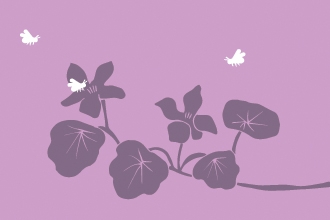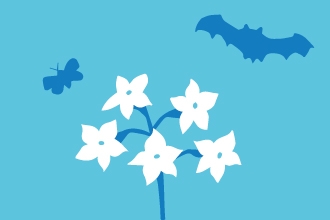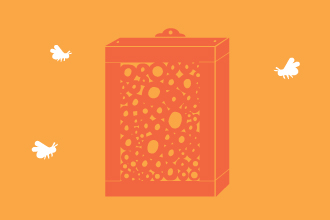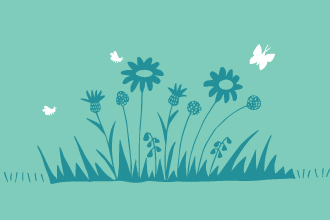
Working to protect pollinators
Our wild pollinators are in trouble. More than HALF of Cumbria and the UK's bee, butterfly and moth species have declined in the past 50 years.
We've pollinators to thank for every third mouthful we eat. Not only do they pollinate our food crops, but they’re also vital for the survival of other wild plants that support so much of our wildlife.
Why pollinators are important
Pollinators may be tiny but their impact is huge.
Most of us tend to think of bees in relation to pollination, yet insect pollinators are an incredibly diverse group. Cumbria is home to approximately 5,000 species of wild insect pollinators, including bumblebees, solitary bees, hoverflies, beetles, butterflies and moths.
We've pollinators to thank for every third mouthful we eat. Honeybees are domesticated and are mostly kept in managed hives, and likely responsible for pollinating between 5-15% of the UK's insect-pollinated crops. That leaves 85-95% of the UK’s insect-pollinated crops relying on wild pollinators.
Not only do they pollinate our food crops, but they’re also vital for the survival of other wild plants that support so much of our wildlife.
There are a number of ways that plant species go about the important business of pollination, an act essential for reproduction in most plants. They can use the wind, or direct contact with flowers, but perhaps the niftiest way is to use a willing insect courier, duly rewarded with a shot of sweet nectar.
Donate to help our pollinators
Around 80% of UK plants are pollinated by insects, including a large number of our crops. It has been estimated that the value of insect-pollinated fruits and vegetables grown in the UK is about £220m a year.
The importance of pollinators talk by Steven Falk (https://youtu.be/100obiZc5oI)
The importance of pollinators, a talk by Steven Falk
Steven Falk, one of Britain's leading natural historians, discusses the different types of pollinators and what we can do to give them a boost.
On 1 July 2020 Prof Dave Goulson gave an illustrated online talk for Get Cumbria Buzzing! on how can we can all help to prevent an insect apocalypse.
Watch his presentation and discover how we can tackle this crisis, by turning our gardens into oases for wildlife and fundamentally changing the way we grow food.
Solitary Wasp on Euphorbia © Richard Burkmar
Planting for pollinators
The Planting for pollinators project aims to reverse pollinator decline in Cumbria.
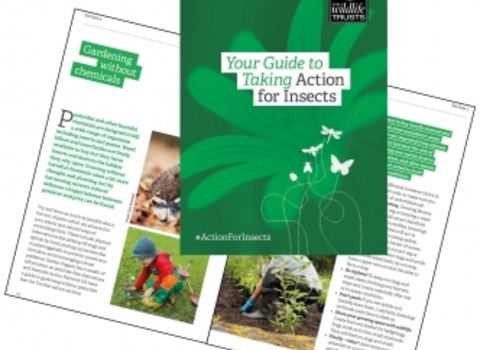
Action for Insects
The drastic decline of insects we have witnessed over the last 100 years affects us all. Get your FREE Action for Insects guide and start to make a difference today.
GetCumbriaBuzzing! project 2019-2022
A network for pollinators
We've created a diverse range of habitats along the A66 and A595 Strategic Road Networks. Using innovative techniques we created short flowering lawns, flower rich grassland, sunny banks, glades, and tussocky areas to provide overwintering refuge for wild pollinators. And by adding important pollinator plants such as goat willow, devil’s-bit scabious, clovers and trefoils, pollinators have a forage from spring to autumn.

Our roads, B-Lines & community sites
Roadside verges
For the 155,000 people commuting to work by road every day in Cumbria, a fleeting view of the road side verges can be their only daily contact with nature. Apart from being a soothing green backdrop verges can bring colour to our everyday lives, brighten up our everyday travel, and help us connect with nature.
They can be better for us, and better for wildlife, particularly plants and the insects that depend upon them. More than 700 species of wild plants are known to exist on our roadside verges and they're a vital refuge for our wildflowers and a valuable resource for pollinators, but to maintain them they need our care and attention.
Here in Cumbria, road verges are managed by a combination of National Highways and Cumbria County Council. As part of Get Cumbria Buzzing! project between 2019-2022, we worked closely with our partners and funders and restored or created 39.43 hectares of pollinator friendly flower rich habitat on the strategic road network and restored or created 80.4 hectares of pollinator habitat at community sites.
Over the last ten years we’ve worked in collaboration with experts and road verge management organisations to come up with the best ways to improve the environmental value of road verges so that roads connect and benefit a wide variety of species not just us humans.
National Highways Work – a case study
A road to recovery for pollinators: roadside verge management
Managed correctly roadside verges can provide a lifeline for pollinators and other insects, providing corridors of connected habitat enabling different species to move more freely across our landscape.
However, often road verges are cut too frequently and at the wrong time, or not cut at all and become scrub. They need to be restored to bring them back into condition and managed into the future.
Investing in biodiversity
Within Cumbria, National Highways are responsible for the A66, M6, A590 and part of A595. In 2015 ring-fenced environmental funding from the Government’s road investment strategy was made available for different habitat creation and restoration projects.
As a result of this investment, Cumbria Wildlife Trust has worked in partnership with National Highways and other agencies, ecologists and conservation bodies to develop projects to research, pilot and develop strategies and appropriate management to increase biodiversity on the road verges that National Highways manage, without compromising road safety.
This has provided opportunity to make fundamental changes to the ongoing management of verges, and a range of other environmentally driven projects are now being delivered along these road networks in Cumbria, including Get Cumbria Buzzing! project.
Work on the ground
Led by Cumbria Wildlife Trust, Get Cumbria Buzzing! was a partnership project that was directly focused on increasing the abundance and diversity of pollinators in the north west of the county along ecological networks, which includes parts of the A595 and A66.
Species–rich grassland is one of the best habitats to support a diverse range of pollinators. Interspersed with scrub, trees, and hedgerows and undisturbed tall grass, they together provide a variety of habitat which benefits both flora and fauna.
Get Cumbria Buzzing! restored 115 hectares of pollinator friendly habitat, which includes 39 hectares of verge habitat.
Elsewhere, National Highways delivered habitat restoration and creation schemes on the A590 and M6. In total, across Cumbria, approximately 120 hectares of species rich verges spanning over 200km (A66/M6/A590/A595) has been restored and created so far.
Ongoing management
Annual grass cutting is planned every August and September to reduce the nutrients in the soil, which in turn reduces growth of competitive grasses and allows native wildflowers to flourish, and prevents grassland reverting to rank grass and scrub.
This management is in line with ‘Plantlife Managing grassland road verges: A best practice guide’
This huge operational task is carefully planned to minimise costs and disruption.
Road safety is paramount
Besides increasing biodiversity, ensuring the safety of people who travel and work on roads is paramount. To maintain visibility and prevent encroachment Highways England undertake maintenance and safety cuts throughout the growing season.
To allow safe access for break downs, visibility of the safety barrier and inspection of the highway, the immediate verge (2m) from the kerb line is cut twice a year.
In addition to this, 200m lengths on either side of junctions are cut to maintain sight lines and visibility. Vegetation is also cleared on the approach to signs to ensure they remain visible. Verges around footways and cycleways are maintained to remove obstructions such as overhanging branches for cyclists and pedestrians.
Innovative equipment
The use of machinery improves safety for road workers and minimises disruption to road users and residents. Latest machinery including robocut/cut and collect mowers are more efficient and precise than alternatives such as manual strimmers and rakes, providing flower rich habitats that better support native pollinators and their predators.
A site walkover before working on the verge sites ensures minimal impacts to species present on the day of the works.
Since partnership working began in 2015, National Highways and Cumbria Wildlife Trust have also worked closely with a wide range of road engineers, operations managers, and others engaged with verge management to share knowledge, learning and best practice which in turn has helped to inform latest guidance and a national approach to road verge management.
Whilst ongoing monitoring and assessment will continue to inform current strategies, this approach underpins ongoing management of Cumbria road verges managed by Highways England, and partnership projects such as Get Cumbria Buzzing!
What are B-Lines?
Simply put, B-Lines are an imaginative and beautiful solution to the problem of the loss of flowers and pollinators. The B-Lines are a series of ‘insect pathways’ running through our countryside and towns, along which we are restoring and creating a series of wildflower-rich habitat stepping stones.
They link existing wildlife areas together, creating a network, like a railway, that will weave across the British landscape. This will provide large areas of brand new habitat benefiting bees and butterflies– but also a host of other wildlife.
Imagine trying to travel around Britain without our road and rail network. Or imagine if nine out of every ten miles of road just didn’t exist – life would be impossible! Well for much of our wildlife this is the reality – it is confined to tiny fragments of habitat and unable to move across the countryside as our climate and landscape rapidly changes.
Get Cumbria Buzzing! has been guided by the national work on B-Lines led by one of our partners, the charity, Buglife.
Our Community Sites
As well as National agencies, the mission of Get Cumbria Buzzing! was shared with a number of partners across the North and North West of Cumbria. Our shared commitment was to repair and restore many sites in community areas for the benefit of people and pollinators.
We worked with our project partners to transform school grounds, community parks and green spaces into pollinator havens in the coastal towns of Workington, Whitehaven, Maryport and along the Solway Coast.
Allerdale Borough Council
The following sites have been repaired and restored and are maintained through the Workington Nature Partnership:
Harrington Nature Reserve, Siddick Ponds, Workington Hall Parklands, Bankfield, Mansion Gardens, Town Quay, Derwent Howe, Brow Top, Maryport Coastal Park, Shore Road and Harrington Harbour
Full details of sites can be found at Reserves & Open Spaces | Nature Partnership
Copeland Borough Council
The following sites have been repaired and restored and are maintained through Copeland BC:
Whitehaven Cemetery, verges, Mirehouse South, Pow Beck Park and Meadows, Whitehaven Castle Park and Distington Crematorian and walled garden.
Solway Area of Outstanding Natural Beauty
The following sites have been repaired and restored and are maintained through the Solway Coast Area of Outstanding Natural Beauty
Crosscanonby Carrs, Allonby Green and Burial Ground, the Roman Milefortlet 21 near Crosscanonby,
St Mary’s Church, Crosscanonby , Maryport Cycleway, Beckfort Burial Ground and Port Carlisle Seafront.
National Trust
The following sites have been repaired and restored and are maintained by the National Trust:
Haig Grasslands in Whitehaven and the colourful coast. Full details of National Trust sites
Pollinators in the heart of the city – a case study in Carlisle
The Swifts, a former golf course and driving range, is a 17-hectare site in the centre of Carlisle which includes grassland, woodland and riverbanks. This site will be transformed into an urban nature reserve thanks to £80,000 funding from Cumbria Waste Management Environment Trust (CWMET) and £8,000 from the Environment Agency.
The funding will breathe new life into the site, transforming once manicured greens and fairways into wildflower meadows, species-rich wetland and native woodland, helping to boost populations of bees and butterflies.
With improved access and signage, and within close walking distance of Carlisle city centre, the site aims to be an oasis for wildlife and people alike.
Already work has been carried out to remove some of the non-native trees on site which had very limited value to native wildlife and were causing dense shading of the woodland floor. This was followed up in autumn 2021 by the planting of approximately 1,200 native flowering tree species and 300 native flowering shrubs.
In partnership with Cumbria Wildlife Trust a seasonal wetland will be created to form a wet grassland. Wildflower seed and wildflower plugs grown at Get Cumbria Buzzing!'s Gosling Sike nursery, have been spread and planted in the meadow areas to increase the diversity of species on site. This work will greatly boost the population of bees and butterflies within reach of the centre of Carlisle.
Pollinators and People
As well as the vitally important work of creating and connecting pollinator habitats, we've created a buzz about pollinators in the communities of North and North West Cumbria.
As part of the project we have:
- helped our Partners to host 16 arts events attended by over 600 adults and children.
- held a children’s photographic competition in 2020 which drew 85 entries from children across Cumbria.
- held 21 pollinator gardening events and gardening webinars drawing a total audience of over 1200 people.
- designed and developed a pollinator friendly gardening guide, a trail tale sheet and a pollinator spotter sheet. All are available for free and have been distributed widely.
- led on Pollinator identification workshops enabling 400+ people to either learn how to identify pollinators or to improve their existing identification skills.
- designed and developed a pollinator identification guide for free distribution.
- Our ‘Improve Your Garden for Pollinators’ post code map has recorded 275+ gardens and green spaces that have been improved to benefit pollinating insects.
- We held pollinator friendly gardening workshops for local Cumbrian residents and created gardening guides, pollinator identification guides and spotter sheets to distribute amongst households in the project area.
- held pollinator identification training sessions to help people understand what they see. We worked towards creating an online Bees, Wasps and Ants Atlas for volunteers to record and map pollinator species within the county.
- We've nearly 100 volunteers regularly identifying pollinators and 150+ people submitting records to the Cumbria Bio Diversity Centre enabling it to record nearly 2000 pollinator records to improve the county and national pollinator databases.

Free resources helping you to support pollinators
Browse below for ideas and inspiration on how you can make a difference for pollinators.
Download our free Wild Bee Spotter Sheet for pollinator identification tips by clicking the link below (PDF)
Download our free Help Bees Action pack for simple tips to help pollinators by clicking the link below (PDF)
Download our beginner's guide to wild pollinators in Cumbria (PDF)
Download our beginners guide to gardening for pollinators by clicking the link below (PDF)
Click the links below for recordings of our webinar series:
- An introduction to identifying and recording butterflies: Common species
- An introduction to identifying and recording butterflies: Specialist species
- Pollinator friendly gardening: Planters for pollinators
- Pollinator friendly gardening: Edible plants to attract pollinators
- Pollinator friendly gardening: Creating new plants for pollinators
- The Importance of Pollinators with Steven Falk
-
Get Your Garden Buzzing - Tips for making your green space pollinator friendly
-
Herbicides, their effect on pollinators, and what we can do to help
-
The Secret Life of Flies with Dr Erica McAlister
Click below for more information about National Highways' (formerly Highways England) biodiversity plan, environment strategy and funding:
- National Highway's Environmental Sustainability Strategy (https://nationalhighways.co.uk/our-work/environment/environmental-sustainability-strategy/)
- National Highways' environment fund (https://highwaysengland.co.uk/designated-funds/)
- National Highways' Protecting the Environment PDF (https://highwaysengland.co.uk/media/u20b3kvg/protecting-the-environment.pdf)


